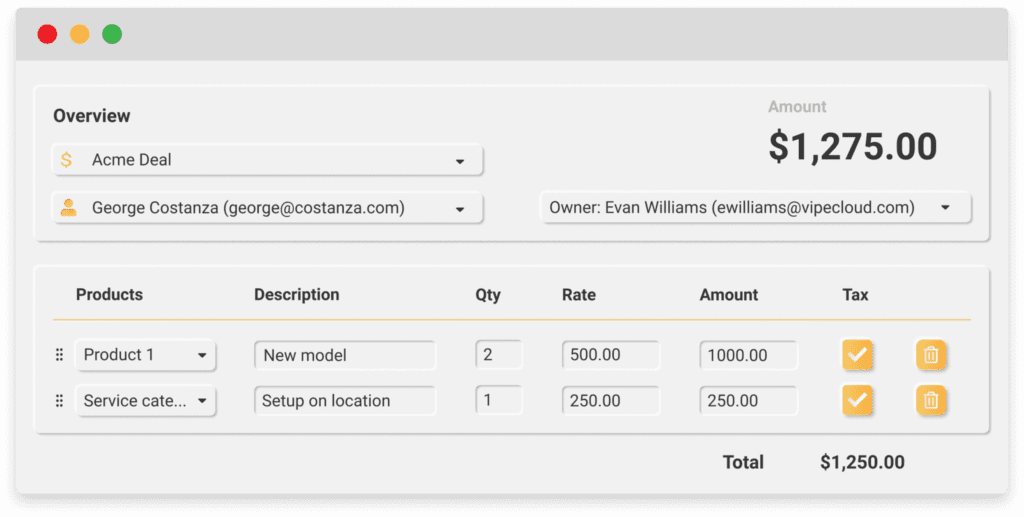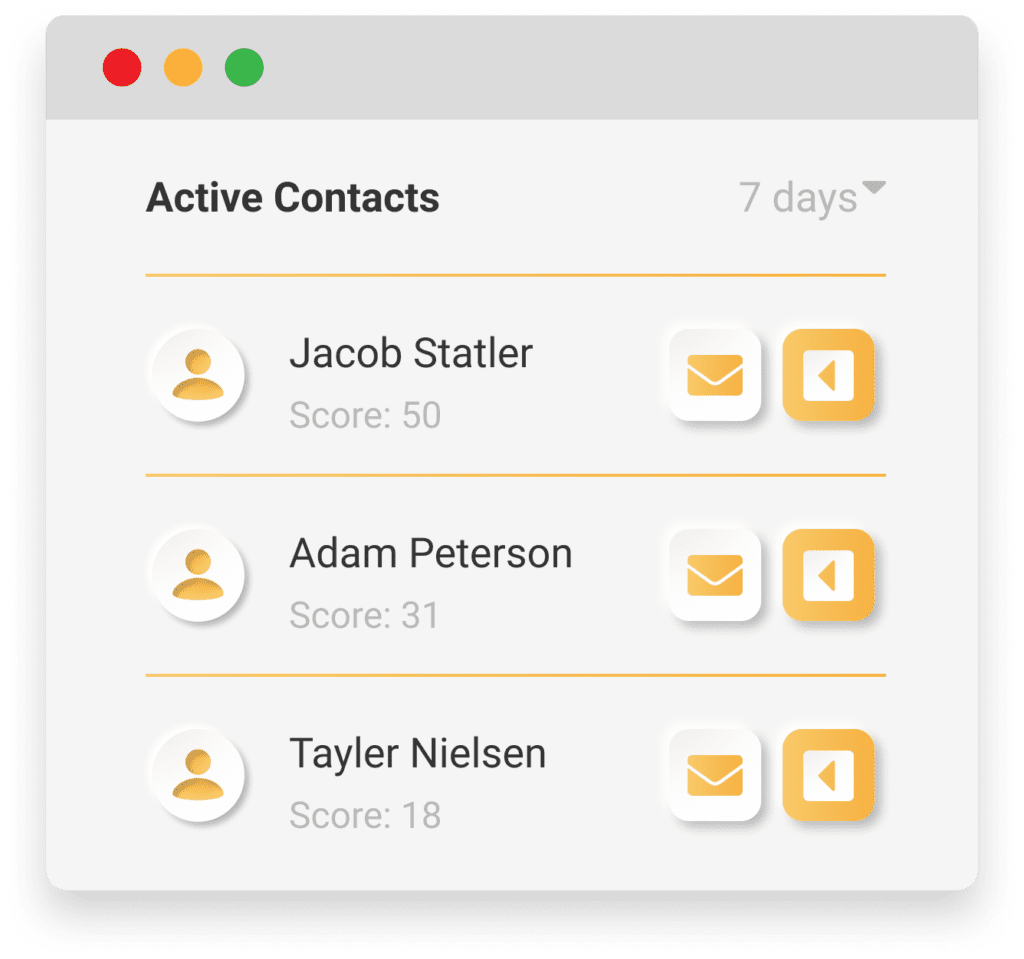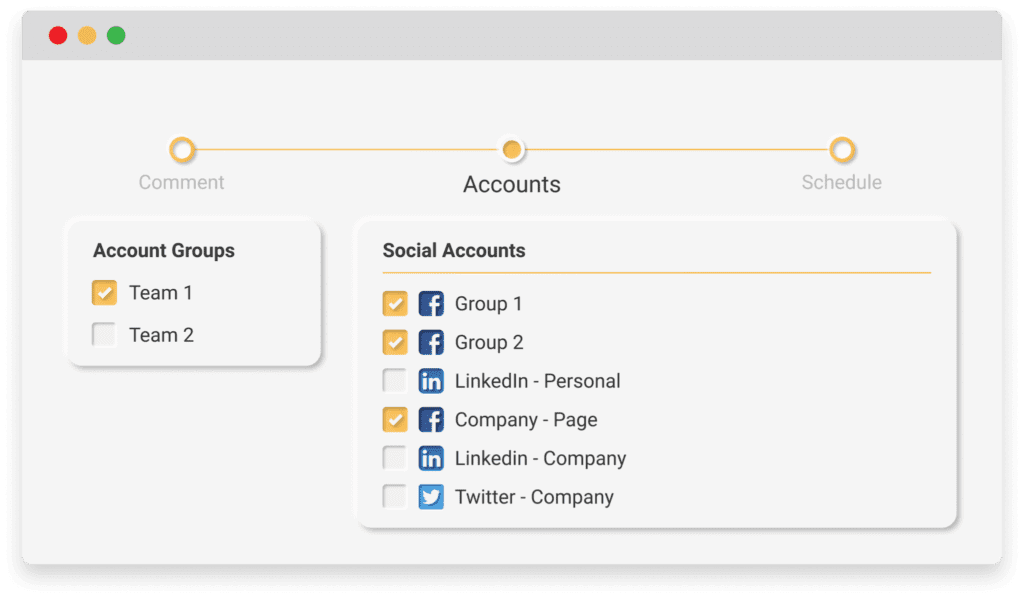Last updated on August 9th, 2023

Today you’ll learn the art of applying an effective sales process to maximize the potential of all your deals!
Selling comes with twists and unexpected turns that can make or break companies.
That’s why successful businesses establish sales processes that predictably bring the right prospects from awareness to a conversion!
By implementing everything in this article, you’ll upgrade your sales process in a proven way.
Here’s what you’ll learn:
- What Is A Sales Process?
- Why Is A Sales Process Valuable?
- What Are The Steps Of The Sales Process?
- What Are Common Sales Process Misconceptions?
- How Do You Improve Your Sales Process?: A 5-Step Procedure
- How Does CRM Contribute To A Successful Sales Process?

VipeCloud is the only Automation tool your small business needs to
be the hero to your customers.
With Email, Texting, Social, Suites, Chat, Stories, Video Email & Sign Up Forms fully built-in, we provide you with the perfect platform to grow your business.
15 Day Free Trial – Get started risk free. No CC needed.
What Is A Sales Process?
Whenever you hear “process,” you can pretty much assume a set of steps are involved in reaching a goal.
The definition for the sales process is simply a series of steps salespeople and companies take to ensure they close qualified prospects AND keep them long-term.
Because if you have the best sales process and team in the world, yet clients are leaking out your business constantly, your profitability can take a hit.
It’s essential not to neglect that your leads come from your marketing. Ideally, you want to think of your marketing and sales as synergistic.
Whether it’s organic (social selling, content marketing) or paid traffic (ads), you first need attention (AKA awareness), then interest from your leads before your sales reps speak to anybody.
Once your rep speaks with the lead, the selling moves them to desire and then action.
70% of potential customers define what they need before speaking with your sales rep, and 44% of them identify specific solutions before connecting with your rep.
With this in mind, make sure your reps are educating prospects on the truly right solutions when connecting.
When it comes to the sales process, the AIDA model is a shortened version of it.
- Awareness
- Interest
- Desire
- Action
Then sales process goes into more detail:
1. Outreach and connection (Lead generation) → Awareness
2. Discovery conversation → Interest
3. Proposal/pitch (your solution) → Desire
4. Follow-up → Desire
5. Close → Action
6. Client Retention → Desire/Action
Sometimes you’ll hear “sales process” and “sales cycle” used interchangeably but keep in mind that a sales cycle is the average length of time it takes to do your sales process steps.
Why Is A Good Sales Process Valuable?
1. Helps You Better Identify Bottlenecks
What’s great about a sound sales process is that the segmentation of your steps lets you better diagnose sales issues.
But the best part?
You can see which KPIs on each stage are affecting things as a whole.
Here’s an example:
Are you getting plenty of leads into your discovery and demo calls, but they aren’t converting to a sales call?
You can conclude that either leads are unqualified or your company isn’t showing the value of your product enough.
Data is what helps you get to the truth.
So if these are your two guesses, you can check the quality of the leads by how they’re scored. If they’re scoring in your SQL range, then you can take measures to improve how you position your product:
- Better value proposition
- Testimonials
- Adding a free trial
- Tying a use-case of your product to the unique pain point of each customer (as long as it actually solves their problem.)
2. A Better Organized Sales Team
When your sales organization knows the steps it takes to bring leads to a close, they’re a lot more organized.
With organization comes higher customer satisfaction because their needs can be met quicker and more precisely. For example, if you have a CPQ system in place that packages the right solution to your prospect’s problem at the right price and sends it to them quickly.
Your prospect will view your company as prompt, professional, and trustworthy.
Being organized also means streamlined communication channels for reps that are responsible for different parts of your sales process.
For instance, your lead generation and discovery call reps communicating the customer’s needs and desires to your sales closers.
With everyone on the same page, the customer experience flourishes.
3. Better Qualified Leads
A sales process brings you better leads because A) you go after ideal prospects (paid ads or organic) and B) you qualify the leads you receive to see if you can help them or you’re both a good fit.
Qualified leads are not only critical for closing, but they’re crucial for customer retention.
In fact, a study has shown that nurtured leads account for 47% of larger purchases than non-nurtured leads.
The longer you can keep customers correlates with how well they fit with your services.
What Are The Steps Of The Sales Process?
This section will focus on the sales process stages, the benefits, and what to look out for. We’ll include several examples that you can adopt into your sales workflow!
1. Outreach & Connection
Your sales process always begins with some form of lead generation.
You want to have a very clear idea of who your customers are and get in front of them. Whether or not they do the next steps with you, you’ve completed the pivotal top-of-funnel awareness stage.
- What is their role in the company (CEO, VP, Director of Marketing?)
- What problems are they facing (You can incorporate this into your pitch or outreach template)
- What is the typical company size of my ideal customer?
- What do they find valuable?
Now, here are some ways of doing outreach and generating leads:
- Email lead generation (cold or warm)
- Social media outreach and groups (For B2B, LinkedIn and Facebook are a goldmine.)
- Social media ads
- Cold calling
You also want to get a good understanding of how many leads you typically need to close a sale. You can get a glimpse of this by accessing the insights in your CRM.
You can look at your “deals won” percentage for maybe a given month and track how many leads it took to close a sale.
As the first step of your sales process, you’ll find that outreach and lead generation will need the most tweaking, especially if you’re just getting started as a small business.
2. Discovery Conversation
This second step to a successful sales process:
A discovery conversation is when you learn more about your lead, their business, and current problems. (Can be done over the phone, video conferencing, or in-person.)
Remember, the discovery phase of your sales process is also for qualification to see if you can help them and if they’re the right fit for you.
This is where a sales methodology or “framework” comes in handy because you can figure out the “what, when, and why” a lot easier.
We have an entire article dedicated to BANT sales, a way of asking qualifying questions that let you figure out your prospect’s budget, authority, need, and timeframe.
A good discovery call needs good discovery questions because it’ll allow you to gather the information to form a solution.
Here’s another key aspect of discovery calls:
If you’re setting a KPI for the number of clients you want per month, just like lead generation, you should figure out how many discovery calls it takes to get a client.
Here’s how to calculate it:
Say you gained 7 clients after having 28 discovery calls. Then, you would divide the number of clients acquired by the total number of discovery calls and multiply it by 100, which in this example, is 25%.
So you know you’ll need about 4 discovery calls to get 1 new client (average given month).
3. Solution
The solution phase happens after a sales rep has considered everything your prospect said and is crafting a solution for them.
Your solution’s use-case should be so good that it’s essentially a “no-brainer” to your prospect. Of course, this doesn’t mean there won’t be objections, but it does mean the value is very evident.
A solution can be found through:
- Professional expertise
- Proven results from previous clients that were similar
- Proven industry solutions
The solution is usually incorporated in a proposal, presentation, or business document, and its purpose is to pitch the value proposition of the product or service.
Also, make sure your solution is adequately priced.
What do I mean?
For starters, the solution phase of the sales process can get “messy.” Often sales reps may offer out-of-date solutions and send incorrect price quotes.
To combat this, VipeCloud has created an easy-to-use configure-price-quote system called: Estimates.

It lets you accurately create pricing quotes for your products and send them via email.
What’s more, is that you can track how your prospect has interacted with the quote after sending it.
Pro-Tip: If you’re in a more technical industry, think of having a technical expert (an engineer, for example) in your company join the salesperson in the meeting to answer the more “nuts and bolts” questions.
Sometimes sales reps may close on after the sales presentation. But more often than not, reps will have to follow up!
4. Follow-up
“The fortune is in the follow-up.” – Jim Rohn, entrepreneur, and author.
Following up with your leads is the best way to stay top-of-mind and keep the deal alive.
There’s evidence that 80% of your sales are made at the 5th-12th contact. So with this in mind, it’s also vital to keep your sales follow-ups dynamic.

What I mean is to think of different ways for your sales team to re-engage prospects. Here are some ideas to get the juices flowing:
- Provide value – Share knowledge resources, company eBooks, free webinars.
- Use different marketing channels – Do your touchpoints via email, social media, and calling as well. (Using CRM makes this super easy!).
(Pro-Tip: Opening your phone call by mentioning why you’re calling will boost your success rate by 2.1x)
- Vary the length of your follow-up – Keep most of your messages concise and throw in longer touchpoints now and again (Short messages do great for social media, longer messages are better in an email).
- Use different content – Follow up with case studies, re-mention your product’s value, send short videos using Loom, and try asking if they’re still experiencing the same pain point.
With dynamic follow-ups, you’re setting yourself apart from the average company that either doesn’t follow up or uses the same monotonous follow-up.
Lastly, Have a uniform follow-up number and cadence across your organization.
For example, maybe each sales rep should have 6 touch points across a 3-week period (21 days).
A rule like this should be incorporated into your sales playbook, especially for new hires to easily get up to speed with how you run things.
5. Handling Objections
Despite your solution’s evident value, your prospects will likely have some doubts, questions, or objections. They might want a better price, have concerns about implementation, or question the product’s fit. This is natural and is a crucial part of the sales process that salespeople need to master.
Sales reps need to listen to the objections carefully, empathize with the prospect, and then respond by showing how the product or service can address their concerns.
6. Proposal Review
Most customers will want to review the proposal. They might even ask for amendments or more information. This step involves revisiting your proposal, refining it, and ensuring it aligns with your customer’s needs. It’s a back-and-forth process, which requires patience.
7. Negotiation
Negotiation often comes into play before the final agreement is reached. It involves working out the terms of the deal, which may include price, delivery, payment terms, and more.
Your sales team must be equipped with the right negotiation skills to strike the balance between maximizing revenue and satisfying the customer’s needs.
This step can make or break the deal.
8. The Close
The close is when the hard work pays off.
It’s where some late-stage activities will happen, including delivering a quote, providing paperwork, and possibly negotiating.
This part of the sales process should be as smooth as possible, which means automation should be incorporated.
Once the salesperson asks for the sale and manages objections, billing, and any contracts that need to be signed should be sent with ease.
As mentioned earlier, a CPQ is a sales enablement system that works great for sending quotes, and you’ll find that your sales reps will have more time to chase the next deal.
Once the lead becomes a client, they should be moved to the “Deals won” section of your CRM and sent the appropriate documents (onboarding forms, welcome documents, etc.)
Pro-Tip: If you’re in B2B, have reps give some positive background info on the new client’s account manager. This will create an excellent first impression.
9. Onboarding
The sales process doesn’t end when you close the deal. Onboarding is an essential step to ensure the client gets off to a good start with your product or service. A well-executed onboarding process helps set the foundation for a long-term relationship.
It involves training the customer on how to use the product, answering their queries, and providing any necessary support.
10. Client Retention
Believe it or not, sales process management doesn’t end once your prospect signs on the dotted line.
The truth is, you’re always selling your customer on your company’s value through your service delivery, professional communications, and asking them how they feel about the service.
On top of that, you must be mindful of the results they’re getting and recommend the right products that’ll continually fix their issues and keep them long-term.
So that makes client retention a pivotal part of the sales process that shouldn’t go unnoticed.
If you’re a B2B business, this is where your account managers come into play. They’re your “salespeople” that come after your salespeople, if you know what I mean.
By communicating with the customer and upselling where it makes sense, the customer experience gets better, and there’s a higher chance they’ll stick with your company over competitors.
And get this:
Just a 5% increase in customer retention can increase your bottom line by 25% to 95%!
11. Referrals and Testimonials
Another step often missed in the sales process is the gathering of referrals and testimonials. Satisfied customers are one of the best sources of new business.
So, after a sale is complete and the customer is happy with the product and service, ask for a referral or testimonial. You can use these in marketing materials to significantly boost the credibility of your business.
12. Continuous Relationship Management
Building and nurturing relationships with your clients is a long-term process. Regularly check in with your clients, ask for feedback, and offer help if needed.
By maintaining a relationship, you’re not just promoting client retention, but also opening opportunities for upselling and cross-selling.
What Are Common Sales Process Misconceptions?
“One Sales Methodology Is The End All-Be-All.”
It’s not uncommon for sales managers to think the way they do sales can make up for their entire sales process.
But there’s a difference.
Your sales method (SPIN, SPAN, BANT, Socratic selling, etc.) is just a selling template to gain information about your prospect and position yourself as the solution.
But if you have a lousy sales process, you’ll find key things you should be doing outside of sales meetings are neglected:
- Lack of follow-ups and nurturing
- No sales automation in place
- Poor customer experience
- No sales analysis
When you think in this way, you’re fundamentally ignoring central pillars that close a deal and keep customers around long term.
“A Great Sales Process = No Need To Measure Progress.”
Like many systems in your business, your sales process needs to be revisited consistently because it has so many moving parts.
Outreach and lead generation alone can see numerous tweaks in just a given month, so imagine the whole pie!
Measuring your progress comes down to comparing how your deals are going compared to previous months and quarters.
Your CRM reports should give you a good birdseye view, but also asking your sales reps what they think can be improved upon during your sales meetings goes a long way.
Maybe your sales life cycle is shortening, or better leads are coming through since you’ve changed up your process…
Whatever the case:
This doesn’t mean it’ll be like that forever, so improvement is needed.
“Marketing Doesn’t Need To Sync With Sales.”
Without some form of marketing, sales just can’t live up to its potential. So whether you’re social selling, cold calling, or running Facebook ads, your marketing should sync with your sales digitally.
And whether your outsourcing your marketing to an agency or have it in-house, your marketing team should be in communication with sales reps so that everyone is on the same page about things like:
- How leads are distributed
- How leads are scored
- Customer profiles (ideal customers)
- Good leads vs. bad leads
When it comes to digital synchronization, using an all-in-one CRM like VipeCloud really does the trick.
Not only can you sync leads and data from all your marketing channels but you have your sales team communicate using one system rather than a dozen.
How Do You Improve Your Sales Process?: A 5-Step Procedure
1. Analyze Your Team & Current Process
For starters, improvement comes from understanding and accepting where you currently are.
So for your sales process to get squeaky clean, you should take inventory of how your team is performing and your current steps.
You can accomplish this through a SWOT analysis:
- Strengths – What stage(s) are working? (Good conversion rate)
- Weaknesses – What stage(s) is your organization weak on? (Low conversion rates)
- Opportunity – What actions can you take? (Hire more reps, change your offers, adopt new sales materials)
- Threats – What happens if your current process continues? (Revenue down-trend, a revolving door of sales reps, etc.)
With this analysis, you can better pinpoint your problem areas.
2. Speak To Customers & Listen To The Marketplace
Listening to your customers helps you think like them.
Collecting customer data and feedback will help you better target and segment an audience that you’ll be able to consistently close.
It’ll also help you tailor your process to your ideal customer.
Maybe your sales team did something consistently at the beginning that got you deals but stopped for some reason. It’s a good idea to revisit what you’ve done previously.
Market research is a great help in figuring out what prospects want from your reps.
For example, if an online review of a competitor, let’s call them “Company A,” mentions how a sales rep from that company wasn’t really answering product questions directly and was just rushing the sale:
You can take that information and add a sales play that outlines how to convey product information specifically.
The combined feedback you implement can be what empowers your organization to improve on the sales front.
3. Apply Your Plan
This step is pretty self-explanatory. With the weaknesses identified through your SWOT analysis, your organization should begin implementing the new changes.
A good idea would be to create a sales process flowchart that outlines your steps.
Show this flowchart during your team meetings, mention the sales team’s new direction, and provide the sales enablement materials for your new steps.

For example, say you’re implementing VipeCloud’s Contact Scoring feature from the Sales CRM to score your leads. You’ll want to provide documented information on it and hold some training meetings before officially implementing it.
Once everyone is trained up, sales managers will have less “teaching” on their plate and can focus on the sales process as a whole.
4. Identify, Measure & Forecast Your KPIs
To know how your new strategy is working, you have to track and compare your numbers.
So, for instance, if your sales process was struggling with following up, you can test out new dynamic follow-up methods and cadences (mentioned earlier) and see how many more booked appointments you get than before.
Try setting a goal for each KPI on each stage of your sales process and use your CRM to see how you’re progressing!
If you’re meeting your goals or your numbers are improving, then you’re heading in the right direction.
If things still aren’t bearing fruit, keep testing or think of bringing in a sales consultant to help you form and implement newer sales blueprints..
5. Automate Where Necessary

Automating some parts of your sales process brings efficiency.
How to automate the sales process?
Here are some ideas:
- Use your CRM to create follow-up drip campaigns
- Automate lead distribution to the right sales reps
- Automate your social selling
- Have leads book a time using your calendar (VipeCloud’s Scheduler feature syncs your appointments easily.) and have the appointment sync to your tasks
- Score your leads
Automation gets crucial the more a business grows, but this doesn’t mean small businesses are off the hook.
Getting used to how automation works from the get-go can mean getting a head start on creating learning documents for your team when it comes time to scale!
How Does CRM Contribute To A Successful Sales Process?
As just mentioned, automation can play a vital role in a successful sales process.
Through time, measuring how your deals are progressing is essential because even the best sales processes need tweaking.
Fortunately, VipeCloud has crafted a sales CRM you can tailor to your business that comes with the crucial sales technology you need to stay competitive.
So try-out VipeCloud’s Sales CRM for a free 15-days.
And if you have questions for us, you can request a demo here, and we’ll answer them!
Sales Process FAQs
A full sales cycle, often known as sales process, refers to all the steps that a salesperson takes from the initial interaction with a potential customer to closing the deal. Essentially, it’s the journey a prospect goes through from being a lead to becoming a customer. It usually includes stages like lead generation, initial contact, qualification, presentation, handling objections, closing, follow-up, onboarding, and retention.
The length of a sales cycle can vary significantly depending on the industry, the nature of the product or service, and the complexity of the sales process. It can range from a few minutes for a simple retail sale to several months for complex B2B sales.
Improving a sales process often involves regular analysis and refinement. Here are some ideas to improve your sales process: Use CRM data to identify bottlenecks or areas where prospects drop off. Offer regular training to your sales team. Implement feedback from salespeople and customers.
Keep an eye on industry trends and best practices

Leave a Reply